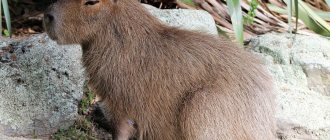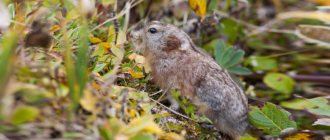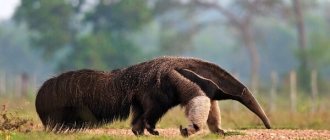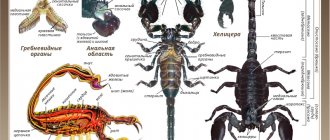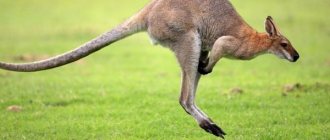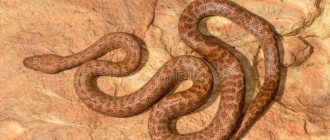Description and appearance features
The tapir is a representative of the order of odd-toed ungulates. Translated from the language of South American tribes, it means “thick”, and was nicknamed for his thick skin. The individual has a strong, elastic body with strong legs and a short tail. The forelimbs have 4 toes, the hind limbs have 3. The skin is covered with short, dense hair of different colors, depending on the species.
On the head, the upper lip with the nose is elongated, ending in a heel with sensitive hairs. In this case, a small proboscis is formed, which helps when eating and exploring the surrounding area.
Which is very important if the animal has poor eyesight. The average length of a tapir's body is 2 meters, with a height at the withers of within a meter. The length of the tail is 7-13 cm. Weight reaches 300 kg, while females are always larger than males.
The tapir is an animal with peaceful traits that treats people well, so it is easy to tame. Mammals are a little clumsy and slow, but in dangerous moments they run quickly. Those who like to play and swim in the pond.
Vibrissae
At the tip of the tapir's proboscis there are small tactile hairs called vibrissae. They are the ones who detect the slightest fluctuations in the environment, allowing the animal to explore objects at a safe distance. Thanks to the whiskers, the tapir accurately navigates the terrain, including in the dark. Vibrissae perfectly compensate for the tapir's poor vision. Moreover, the animal has the opportunity to get an idea of objects without touching them.
Kinds
Four species are best studied. Among them, only one lives in the mountains. The fifth species was discovered quite recently.
1. Central American tapir
Body length: 176-215 cm.
Height at withers (height): 77-110cm.
Weight: 180-250 kg.
Habitat: From northern Mexico to Ecuador and Colombia.
Features: One of the rare and little-studied species. Lives in the humid tropics. Stays close to water and is an excellent swimmer and diver.
Appearance: Large mammal of American forests. It has a small mane and coat of dark brownish tones. The area of the cheeks and neck is light gray.
Central American tapir
Mountain tapir
Body length: 180 cm.
Height: 75-80cm.
Weight: 225-250 kg.
Habitat: Colombia, Ecuador, Peru, Venezuela.
Features: The smallest representative of tapirs. Lives in mountainous areas, rising to a height of up to 4000 meters, to the lower boundary of the snow. Rare, poorly studied species.
Appearance: Elastic body ends with a short tail. The limbs are slender and muscular, because the mountain tapir has to overcome rocky obstacles. The color of the coat varies from dark brown to black. The ends of the lips and ears are lightly colored.
Mountain tapir
Plains tapir
Body length: 198-202 cm.
Height: 120cm.
Weight: 300 kg.
Habitat: South America, from Colombia and Venezuela to Bolivia and Paraguay.
Features: The most famous and widespread type. The lowland tapir leads a solitary lifestyle and inhabits tropical rainforests. Females bring one cub, reddish-brown with spots and longitudinal stripes.
Appearance: Compact, strong animal with fairly strong limbs. Small straight, coarse mane. The coat color is black-brown on the back and brown on the legs, abdominal and chest parts of the body. The ears have a light border.
Plains tapir
black-backed tapir
Body length: 185-240 cm.
Height: 90-105cm.
Weight: 365 kg.
Habitat: Southeast Asia (Thailand, southeast Burma, Mallaka Peninsula and neighboring islands).
Features: The only species lives in Asia. They are distinguished by their unique black and white coloration and elongated trunk. It can not only swim, but also move along the bottom of a reservoir. Regularly rolls around in dirty slurry to get rid of ticks and other parasites.
Appearance: The black-backed tapir attracts with its unusual colors. A grayish-white spot (saddle blanket) forms in the back area, similar to a blanket. Other coats are dark, almost black. The ears are also white-rimmed. The fur is small and there is no mane on the back of the head. Thick skin on the head, up to 20-25 mm, is a good protector from predator bites.
black-backed tapir
Small black tapir
Body length: 130 cm.
Height: 90 cm.
Weight: 110 kg.
Habitat: inhabits the Amazon (Brazil, Colombia)
Features: Discovered recently using camera traps. The female is larger than the male. The smallest and poorly studied species.
Appearance: Individuals have dark brown or dark gray fur. Females have a light spot on the lower part of the chin and neck.
Small black tapir
Cultural references[edit]
South American tapir pottery from Suriname, made before 1914.
In Chinese, Korean and Japanese, the tapir is named after a beast from mythology with a snout like an elephant. In Chinese and Japanese folklore, tapirs, like their chimerical counterparts, are believed to eat people's nightmares. In Chinese, the name of this beast, and then the tapir, sounds like mò
in Mandarin (貘) and mahk in Cantonese (貘). The Korean equivalent is maek (Hangul: 맥, Hanja: 貘 [출처] 테이퍼 [貘, tapir]), while in Japanese it is called baku (獏 or 貘) (バク).
In prehistoric scenes of the science fiction film 2001: A Space Odyssey, tapirs appear alongside primitive hominids in Africa. There is no evidence that tapirs ever existed in Africa, so it is likely that they were added simply for their "prehistoric" appearance. [42] In the film's novel, the hominids instead coexist with warthogs, which they learn to hunt for food. [ citation needed
]
Mark Tapir - character from the animated series Sonic Boom
.
He's a parody of the stereotypical obsessive fan. [43] Drowzee and Hypno from the Pokémon
are based on tapirs, [44] their ability to eat dreams is derived from the baku. The Pokémon Munna and Musharna are also based on tapirs and also have the ability to eat dreams.
In the video game The World Ends with You: Final Remix
a noise that takes the form of a huge tapir traps the characters in an alternate fairytale version of Shibuya.
Luna from the Animal Crossing
- A female tapir who runs the Dream Suite. The moon is a guide for the player who goes into sleep to dream about another player's city or island.
Many groups or individuals within the ex-Mormon movement will use the tapir as a symbol due to defenses made by Mormon apologists who have stated that horses in ancient America mentioned in the Book of Mormon may have been tapirs. [45]
Habitat and lifestyle
One of the most ancient mammals. Now only 5 species have survived. The enemies of animals on land are jaguars, tigers, anacondas, bears, and in water - crocodiles. But the main threat comes from humans. Hunting reduces the population, and deforestation reduces the habitat.
When studying the question of which continent does the tapir live on , it is worth noting that the habitat has decreased significantly. The main 4 species live in Central America and warm areas of South America. And the other is in the lands of Southeast Asia.
These mammals love wet, dense jungles, where there is a lot of lush vegetation. And there must be a pond or river nearby, because they spend a lot of time in the pond and enjoy swimming and diving.
Animals are active in the evening and at night, so to find a tapir during the day. Mountain animals are awake during the day. If danger arises, they can switch to a nocturnal lifestyle. During dry periods or when humans have negative influence on their habitat, animals migrate.
Tapirs run fast, can jump, and crawl, because they have to navigate difficult forests with fallen trees or along mountain slopes. My favorite pastime is swimming and diving. And some individuals can feed on algae underwater.
Mexican tapir
Tapirs in lowland areas live solitary lives and often display an aggressive disposition when meeting them. Animals mark territory, so they are hostile to strangers. They communicate with each other using sharp, piercing sounds similar to a whistle. When frightened they run away and rarely bite.
WHAT DOES IT EAT?
Tapir is a herbivore. Its diet includes aquatic and meadow vegetation, branches and leaves of trees and bushes, fruits and other parts of plants. Tapirs prefer young green shoots, as well as grass and cultivated plant varieties. Therefore, it is not surprising that farmers do not like them.
The ability of the tapir to feed on a wide variety of plants can be explained by the fact that the tapir searches for food in the tropical forest, where many poisonous plant species are found. Therefore, the tapir tries to eat many types of plants, but in small quantities.
The tapir is a very picky eater. With the help of the snout that ends the trunk, he explores the ground around him, sniffing the shoots of bushes that grow low above the ground. He has a sensitive sense of smell.
Nutrition
The rich vegetation of rainforests is the main source of food for animals. The tapir's diet includes leaves of trees, shrubs or young palm trees, shoots, and fallen fruits. Those who like to swim and dive in a pond, they can feed on algae from the bottom.
Due to the fact that living areas are shrinking, animals cannot always find tasty fruits. They attack farmland, gnaw away cocoa shoots, and destroy thickets of sugar cane, mango, and melon. This harms the plantations. And the owners take drastic measures by shooting tapirs.
Tapirs love to eat leaves and tree branches
The favorite treat of mammals is salt. Therefore, they travel long distances for her sake. High density of herbivores in the lowlands of Paraguay. Here the soil is rich in sulphate and salt soda, and animals happily lick the soil. They also replenish the need for microelements by consuming chalk and clay.
In captivity, the tapir lives in closed enclosures measuring at least 20 m² and always with a pond. They eat the same food as pigs: vegetables, fruits, grass, combined feed. Due to a lack of sunlight, and therefore vitamin D, the animal may lag in growth and development. Therefore, vitamins and microelements are added to the feed. And the delicacy, of course, will be sweet fruits, sugar, crackers.
Animal in the Moscow Zoo
Our tapir is a female, born in 1986, and came to us from the Berlin Zoo in 2005. Tapirs are herbivorous animals, so the zoo receives boiled potatoes and carrots, lettuce, various fruits, rolled oat porridge with peas, to which vitamins and mineral supplements are added, as well as special feed.
Since the female is no longer young, she has, as they say, character. Any new event or change in the usual routine of life is treated with suspicion. For example, the arrival of mechanics or electricians can unsettle her for half a day, and the need to move to the neighboring cage, where the giraffe is usually kept, while cleaning, turns into a serious problem. Of course, when working with such an animal, special techniques are needed that, on the one hand, make working with it easier, and on the other hand, help the animal cope with inevitable and not always pleasant events. To do this, special classes are regularly carried out with the tapir, during which the animal “obtains” a treat from the keeper, performing simple but necessary actions for care. For example, an animal was taught that in order to get a grape, it needs to touch its nose to a special object - a target. The target is a plastic pin. Thanks to this training, for half a bowl of grapes, a keeper can guide an animal through an enclosure, into an adjacent cage, and even transfer it across the road from a winter enclosure to a summer enclosure and back. Previously, this procedure cost everyone a lot of effort, nerves and time.
Old age also requires serious attention to the health of the animal: veterinary examination, weight monitoring, monitoring the condition of the hooves and, if necessary, treatment. In order for the tapir to allow all these manipulations to be carried out on him, and most importantly, so that they do not cause him stress, special training is also carried out. The animal is taught to go on the scale, allow its legs to be examined, and allow its hooves to be processed if necessary.
As a result of the training, the tapir became more relaxed about all these procedures, and his life became more active and eventful.
Reproduction and lifespan
Sexual maturity of individuals occurs at 3-4 years. The female is almost 100 kg larger than the male, and externally they do not differ in color. Tapirs mate throughout the year and the female initiates this relationship. The process of copulation takes place not only on land, but also in water.
During mating games, the male runs after the female for a long time and makes grunting sounds similar to a whistle or squeal. Sexual partners do not differ in fidelity; the female changes males every year. Tapir pregnancy lasts just over a year, almost 14 months.
Mountain tapir baby
As a result, a baby is born, usually one. The average weight of a baby is 4-8 kg (varies, depends on the species diversity of animals). The small tapir in the photo is different in color from its mother. The coat has spots and dotted stripes. This type helps to hide in a dense forest. Over time, after six months, this coloring goes away.
For the first week, the baby and his mother hide under the cover of bushes. The mother feeds milk while lying on the ground. And starting next week, the cub follows her in search of food. Gradually, the female accustoms the baby to plant foods.
Milk feeding ends after a year. By 1.5 years, the cubs reach the size of adults, and puberty occurs by 3-4 years. On average, under good conditions, tapirs live about 30 years. Even in captivity they can reach this age.
Links[edit]
- ↑
Ruiz-Garcia, Manuel;
Castellanos, Armando; Bernal, Luz Agueda; Pinedo Castro, Mireya; Caston, Franz; Shostell, Joseph M. (2016-03-01). "Mitogenomics of the mountain tapir (Tapirus pinchaque, Tapiridae, Perissodactyla, Mammalia) in Colombia and Ecuador: phylogeography and understanding the origins and systematics of South American tapirs." Biology of Mammals
.
81
(2): 163–175. DOI: 10.1016/j.mambio.2015.11.001. ISSN 1616-5047. - “All about the amazing tapir | Tapir Specialist Group". Tapir Specialist Group
. Retrieved December 1, 2022. - ^ ab Hans, Jeremy. "Scientists make one of the biggest discoveries of the century: new tapir". Mongabay
. Retrieved December 17, 2013. - Gorog, A. (2001). Tapirus terrestris, Animal diversity network. Retrieved June 19, 2006.
- Jump up
↑ Hickey, R. S. Georgina (1997).
"Tapir Penis." Nature of Australia
.
25
(8): 10–11. - Endangered wild animals and plants of the world. Marshall Cavendish. 2001. pp. 1460–. ISBN 978-0-7614-7194-3.
- Prasad, M. R. N. (1974). Männliche Geschlechtsorgane. Walter de Gruyter. P. 119–. ISBN 978-3-11-004974-9.
- Jump up
↑ Gade, Daniel W. (1999). Nature and Culture in the Andes. University of Wisconsin Press. P. 125–. ISBN 978-0-299-16124-8. - Quilter, Geoffrey (2004). Cobblestone circles and standing stones: archeology at the site of Rivas, Costa Rica. University of Iowa Press. P. 181–. ISBN 978-1-58729-484-6.
- ^ a b Whitmer, Lawrence; Sampson, Scott D.; Solounias, Nikos (1999). "The tapir proboscis (Mammalia: Perissodactyla): a case study of the new anatomy of tapirs" (PDF). Journal of Zoology
.
249
(3): 251. DOI: 10.1111/j.1469-7998.1999.tb00763.x. - ↑
Colbert, Matthew (2002) Tapirus terrestris. Digital morphology. Retrieved June 20, 2006. - Ballenger, L. and P. Myers. 2001. "Tapiridae" (online), Animal Diversity Internet. Retrieved June 20, 2006.
- Huffman, Brent. Order Perissodactyla from Ultimate Ungulate
- " Lydekker, Richard (1911). "Odd-toed ungulates". In Chisholm, Hugh (ed.). Brockhaus Encyclopedic Dictionary
.
21
(11th ed.). Cambridge University Press. Page 169-171. - Myers, P., R. Espinoza, C. S. Parr, T. Jones, G. S. Hammond, and T. A. Dewey. 2006. Diversity of cheek teeth. Animal Diversity Network (online). Retrieved June 20, 2006.
- Myers, P., R. Espinoza, C. S. Parr, T. Jones, G. S. Hammond, and T. A. Dewey. 2006. Basic structure of cheek teeth. Animal Diversity Network (online). Retrieved June 20, 2006.
- Tapirs Described, Tapir Gallery
- Janssen, Donald L., DVM, Dipl ACZM, Bruce A. Ridout, DVM, PhD, Dipl ACVP, Mark E. Edwards, PhD. "Medical treatment of captive tapirs (Tapirus sp.)." 1996 Proceedings of the American Association of Zoo Veterinarians. November 1996. Puerto Vallarta, Mexico. Page 1–11
- Eisenberg, J.F.; and others. (1990). "Tapirs". In Parker, S. P. (ed.). Grzimek's Encyclopedia of Mammals, Vol. 4
. New York: McGraw-Hill Publishing. pp. 598–620. ISBN 978-0-07-909508-4. - "Woodland Park Zoo Animal Information: Malayan Tapir (Tapirus indicus)". Zoo.org. Retrieved November 2, 2009.
- Tapir | Animals of the San Diego Zoo.
- ^ ab Morris, Dale (March 2005). "Face to face with a big nose." Archived 6 May 2006 on the BBC Wildlife
. pp. 36–37. - TPF News, Tapir Conservation Foundation, Vol. 4, No. 7, July 2001. See section on Charles Foerster's research.
- "Minimum Livestock Standards: Tapiridae (Tapirs)". Retrieved November 2, 2009.
- ^
Animal Diversity Fact Sheet on Tapirus terrestris - Bell, Catherine E. (2001). Encyclopedia of the World's Zoos. Taylor and Francis. pp. 1205–. ISBN 978-1-57958-174-9.
- Ballenger, L.; Myers, P. (2001). "Family Tapiridae". Animal Diversity Network
. Archived from the original on 2013-04-13. Retrieved May 11, 2014. - Ashley, M.W.; Norman, J. E.; Strauss, L. (1996). "Phylogenetic analysis of the tapirids of the family Perissodactylae using mitochondrial cytochrome c oxidase (COII)". The evolution of mammals
.
3
(4): 315–326. DOI: 10.1007/BF02077448. S2CID 24948320. - Palmer, D., ed. (1999). Marshall's Illustrated Encyclopedia of Dinosaurs and Prehistoric Animals
. London: Marshall Editions. item 261. ISBN. 978-1-84028-152-1. - ^ ab Cozzuol, Massachusetts; Clozato, C. L.; Holanda, E.C.; Rodriguez, F.V.H.G.; Nienow, S.; De Thoisy, V.; Redondo, RAF; Santos, F. C. R. (2013). "A new species of tapir from the Amazon". Journal of Mammology
.
94
(6):1331–1345. DOI: 10.1644/12-MAMM-A-169.1. - "Florida Museum of Natural History Fact Page". flmnh.ufl.edu. Retrieved November 2, 2009.
- Houck, M. L.; Kingswood, South Carolina; Kumamoto, A. T. (2000). "Comparative cytogenetics of tapirs of the genus Tapirus
(
Perissodactyla, Tapiridae
)".
Cytogenetics and Cell Genetics
.
89
(1–2): 110–115. DOI: 10.1159/000015587. PMID 10894950. S2CID 21583683. - Mountain Conservation Tapir at Cheyenne Mountain Zoo Archived June 15, 2006, at the Wayback Machine
- Photos of T. bairdii x T. terrestris cross by Cheryl Todd, Tapir Gallery, Tapir Conservation Foundation website
- "About the tapir specialist group". tapirs.org. Retrieved November 2, 2009.
- "Baird's Costa Rican Tapir Project". Savetapirs.org. 2009-02-18. Retrieved November 2, 2009.
- ↑
"Woman's hand bitten off in zoo attack", Associated Press report, Jay Hughes, November 20, 1998. - "Interview with Carlos Manuel Rodriguez Echandi", IUCN Tapir Specialist Group 2006
- “Dublin Zoo pleads guilty to safety violations in tapir attack on child,” reports The Irish Times Tom Tuite, October 14, 2014.
- Goudeau, Justin (1843). "New observations of the tapir pinchak" [Latest observations of the tapir pinchak]. Comptes Rendus
.
16
: 331–334. The report contains information about wild mountain tapirs avoiding contact with people in salt fields after hunting and hiding. - Buck, Frank (2006). Bring 'Em Back Alive: The Best of Frank Buck. Texas Tech University Press. P. 3–. ISBN 978-0-89672-582-9.
- Tapirs in 2001: A Space Odyssey, Tapir Gallery.
- Tapirs on film, PT 2
- "14 Pokemon You Didn't Know Were Based on Real Animals". February 2016
- Michael Ash. "Horses in the Book of Mormon". Retrieved January 7, 2022. The most likely animals included in the expanded definition of "horse" in the Book of Mormon are deer and tapir.
Interesting facts about the tapir
- Some of the most ancient animals. They live more than 55 million years.
- In 2013, Brazilian zoologists discovered a fifth species - the small black tapir. This is one of the first equids discovered in the last 100 years.
- Distant relatives of these mammals are rhinoceroses and horses. Modern tapirs have some similarities with ancient horses.
- The elongated snout and respiratory tube help the animal when diving. It can submerge under water for several minutes. Thus, escaping from enemies.
- In captivity, tapirs are domesticated and become tame.
- Now tapirs are protected and all species, except the lowland one, are listed in the International Red Book. About 13 species of these animals have disappeared.
- Asian peoples believe that if you make a stone or wooden figurine of a tapir, it will save the owner from nightmares. For this they called him the “dream eater”
- In Brazil, tapirs dive into water and graze. At the bottom of rivers and lakes they eat algae.
- During water procedures, small fish clean the fur and destroy parasites on the skin.
- Animals have a rich diet. They eat more than 100 different types of vegetation.
- Local residents hunt tapir with dogs. And if he does not have time to hide in the water, they overtake him. They value the meat in it. And amulets are made from stones found in the stomach.
Poaching for meat, thick skin and deforestation in habitats has a tragic impact on the population. Uncontrolled extermination of tapirs reduces the animal population and leads to species extinction.
Threats
Such a peaceful and kind animal has a lot of enemies, from which tapirs cannot find salvation either on land or in water.
On the plains they are hunted by tigers, jaguars, anacondas and bears. In the aquatic environment, crocodiles are waiting for them.
However, their main enemy is man. Hunting of tapirs for their meat and skin has significantly reduced their population, and four of the five tapir species are now listed as endangered.
Tapir and man
Man diligently pursues all tapirs for meat and skin. Their meat is considered tender, juicy and tasty. Their thick skin is tanned and cut into belts, which are rounded, made soft by rubbing hot fat into them, and then used for whips and reins. Many similar belts are exported from Argentina to markets every year. According to Tschudi, this skin is not suitable for shoes: it cracks in dry weather and swells in damp weather.
Various healing properties are attributed to the hooves, hair and other parts of the tapir’s body. On the eastern coast of America, the common people, however, do not try the effects of these remedies at all, but are content to offer them to strangers. But the Indians, as Chudi assures us, wear the hooves of these animals on their necks as a preventive measure against epilepsy, and even take them orally in the form of dried and finely crushed powder. This same remedy occupies an honorable place in Indian medical science, since it is also used against consumption, but then it is boiled in cocoa along with the liver of the stinkhorn. Finally, tapir hooves are used by women during dancing as castanets.

